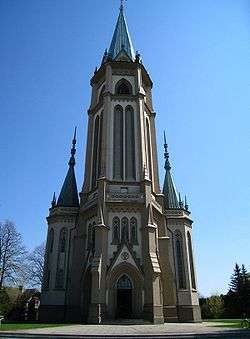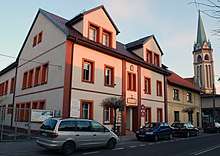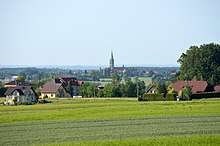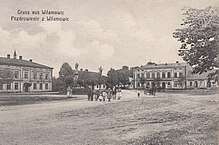Wilamowice
Wilamowice [vʲilamɔˈvʲit͡sɛ] (earlier Willamowice, German: Wilmesau, in local Wymysorys: Wymysoü) is a rural town in southern Poland, situated in the Bielsko County, Silesian Voivodeship (since 1999, previously in Bielsko-Biała Voivodeship, 1975–1998). According to a UNESCO report in 2009, the rural town is also known for the endangered language Wymysorys, a minority ethnolect, one of many Germanic "colonial" dialects spoken in the country since the Medieval period.[2]
Wilamowice | |
|---|---|
 Holy Trinity Church in Wilamowice | |
 Coat of arms | |
 Wilamowice | |
| Coordinates: 49°54′59″N 19°9′7″E | |
| Country | |
| Voivodeship | Silesian |
| County | Bielsko |
| Gmina | Wilamowice |
| Area | |
| • Total | 10.41 km2 (4.02 sq mi) |
| Population (2019-06-30[1]) | |
| • Total | 3,100 |
| • Density | 300/km2 (770/sq mi) |
| Postal code | 43-330 |
| Website | https://gmina.wilamowice.pl/ |
History
According to historians, after the desolation of Polish lands by the Mongol invasion in 1241, the then Silesian Piast rulers of the Duchy of Opole and Racibórz decided to bring settlers from the West to the deserted and destroyed lands around the Silesian Foothills, to revive agriculture, industry and trade.[3] The area was settled in the course of the German eastward colonization of Slavic lands. In this way, around 1250, a group of colonists from the area of former Flanders came to the region, specifically from Friesland, near Bruges and established the settlement Wilamowice.[3]

The settlement was first documented in 1325, in the Peter's Pence register as the parish Novovillamowicz (New-Wilamowice) in medieval Latin, among the Catholic parishes of Oświęcim diaconate, in the Diocese of Kraków.[2] The place name is seen as a demarcation to the older settlement Antiquo-Willamowicz (Old-Wilamowice, today named Stara Wieś).[2][4] In 1529, the two place names were recorded respectively in medieval Latin as Vilamovice Nova and Antiqua Vylamovicze.[2]
In the course of history, the area has been part of several territorial border changes. Politically, both settlements—old and new, belonged to the Duchy of Opole and Racibórz, and the castellany gord of Oświęcim ceded from Lesser Poland around 1177 by duke Casimir II the Just to the duke of Opole—Mieszko I Tanglefoot, which in 1315 was formed in the process of the feudal fragmentation of Poland into the Duchy of Oświęcim, ruled by the local dukes of the Silesian Piast dynasty. In 1327, the Duchy of Oświęcim became a fiefdom of the Kingdom of Bohemia within the Holy Roman Empire.

In the 15th century, Jan Długosz lists the settlement in the diocese of Krakow benefactors register Liber beneficiorum dioecesis Cracoviensis in Old Polish language Wylamowycze, in allodial lordship of the nobleman Andreas of Wilamowic (aka Wilamowski) and the heirs Johannes and Nicolaus Wilamowski.[5][6][7][8] From 1527, owners of the lordship mentioned include: the nobleman Jakob Saszowski of Gieraltowic and Wilamowic,[9] and in 1533: the nobleman and chief judge of Oświęcim Nicolaus Saszowski of Gieraltowic (aka Gierałtowski),[7] in 1633: Christopher Korycinski (castellan of Wojnicz), between 1707–1719 Władysław Morsztyn and his wife Helena née Kalinowska; to the end of the 19th century the owner Psarski sold his land and rights to residents, and from there on Wilamowice became a small rural town.[7]
In 1457, duke Jan IV of Oświęcim agreed to sell the Duchy of Oświęcim to the Polish Crown, and in the accompanying document issued on 21 February the settlement was mentioned in Old Polish language Wylamowycze.[10] It was not, however, until 1564, at the General sejm, that King Sigismund II Augustus issued privileges of incorporation, recognizing the Duchy of Oświęcim as part of the Polish Crown into the Silesian County of the Kraków Voivodeship.

Since the 15th century, the names used in official chronicles were the German versions Wilmeshau and Wilmesdorf for both the new and old Wilamowice respectively.[2] The place name was subject to several vernacular changes over the course of history, and since the 18th century the name Wilmesau in High German prevailed under the ruling Habsburg Monarchy;[2] when in 1772, upon the First Partition of Poland, it became part of the Habsburg's Kingdom of Galicia and Lodomeria, a semi-autonomous protectorate of the Austrian Empire. After World War I and the dissolution of Austro-Hungarian monarchy, it became part of the newly independent nation of the Second Polish Republic.
In 1939, after the joint Invasion of Poland by Germany, the Soviet Union, and the Free City of Danzig, the area was annexed by Germany (see Polish areas annexed by Nazi Germany) in the Occupation of Poland. After the end of the Second World War, Polish territories seized by the Red Army as it advanced westward, were restored to the post-War Polish People's Republic.
Archaic dialect
Due to endogamy and geographical isolation of the settlement in a Polish language region laying nearby the German linguistic enclave around Bielsko-Biala, Wilamowice formed an independent language or dialect (see: Wymysorys language) since the Late Medieval Period, which was in use in everyday life until the end of the Second World War.[2] At the end of the War, whilst almost all Germans in the region were expelled (see Flight and expulsion of Germans from Poland during and after World War II), in Wilmesau—the ancestral population were able to remain. The local language, however, was banned in the Polish People's Republic under the Soviet Occupation Forces and Soviet-backed communist regime, and the local population were partially Polonized. Although the language ban was lifted in 1956 during the "Polish October" revolution, attempts continued however to suppress the Wymysorys dialect from public life.
Today, the Wymysorys dialect is still spoken by less than 70 native speaking residents—the elderly being the majority.[2] The dialect is the result of the transformation of the Flemish language.[3] According to the late professor Marian Szyrocki, a Polish historian and expert of Germanic languages, including the Flemish language, described this dialect as a patchwork of ancient languages: Old Germanic, Old French, Celtic, Gaulish and Romansh, which later crystallized in Dutch or Flemish.[3]
The status of the Wilamowice ethnolect is controversial, because according to the traditional classification of all dialects it is broadly understood as a High German language, and should be considered a dialect of the German language. Nevertheless, the self-determination of its users as a separate group from the Germans and the existence of a literary Wymysorys language (or, to be more exact, micro-language) allows to assume that this ethnolect is a separate language.
Notable people
- Florian Biesik (1849–1926), writer
- Józef Bilczewski (1860–1923), archbishop of Lwów
- Józef Gara (1929–2013), former miner turned author and poet who was the creator of the modern alphabet of Wymysorys and a collector of Wymysorys songs
Twin towns – sister cities
See twin towns of Gmina Wilamowice.
References
- "Population. Size and structure and vital statistics in Poland by territorial divison in 2019. As of 30th June". stat.gov.pl. Statistics Poland. 2019-10-15. Retrieved 2020-02-14.
- Wicherkiewicz, Tomasz (2003). The Making of a Language: The Case of the Idiom of Wilamowice, Southern Poland. Berlin: Walter de Gruyter. pp. 1–2, 5–15, 11–12. ISBN 9783110170993.
- "Historia Parafii" [Parish History]. Parafia Przenajświętszej Trójcy (Parish of the Most Holy Trinity) (in Polish). Parafia Przenajświętszej Trójcy (Parish of the Most Holy Trinity).
- Jan, Ptaśnik (1913). Monumenta Poloniae Vaticana T.1 Acta Camerae Apostolicae. Vol. 1, 1207-1344 (in Latin). Cracoviae: Sumpt. Academiae Litterarum Cracoviensis. pp. 147–150.
- Długosz, Jan (1470–80). Liber beneficiorum dioecesis cracoviensis [Benefactors Register Diocese of Krakow] (in Latin). 7. Krakow: Jan Długosz, Diocese of Krakow. p. 85.
- Długosz, Jan (1470–80). Liber beneficiorum dioecesis cracoviensis [Benefactors Register Diocese of Krakow] (in Latin). 8. Krakow: Jan Długosz, Diocese of Krakow. p. 291.
- Młynek, Ludwik (1907). Narzecze wilamowickie = (Wilhelmsauer Dialekt) [Wilamowice Dialect] (in Polish). Tarnów: J. Pisz. p. 8.
- Niesiecki, Kasper (1839). Herbarz polski [Polish Heraldry] (in Polish). Lipsko: Breitkopf & Härtel. p. 330.
- Kozierowski, Stanisław (1919). Studya nad pierwotnem rozsiedleniem rycerstwa wielkopolskiego: VI Ród Szaszorów-Opalów-Orlów [Study on the primary displacement of the Greater Poland knights: VI House of Szaszorów-Opalów-Orlów] (in Polish). Poznań: Towarzystwo Przyjaciół Nauk Poznańskie. p. 82.
- Prokop, Krzysztof Rafał (2002). Księstwa oświęcimskie i zatorskie wobec Korony Polskiej w latach 1438-1513. Dzieje polityczne (in Polish). Kraków: PAU. p. 151. ISBN 83-88857-31-2.